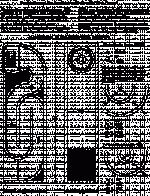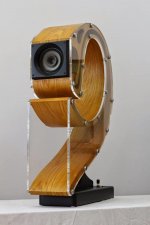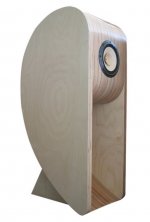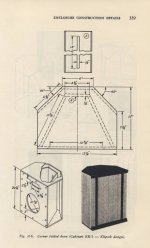That's generally because smooth curves tend to be counter-productive in bass horns. Essential in midrange & HF of course, where you're dealing with short wavelengths, but for BW limited applications like a back-loaded horn, the wavelengths over the operating range are too long to be significantly affected by sharp bends etc., and the latter (as I do in my own designs) are often deliberately designed as functional parts of the acoustic low pass filter.
what's with the VS mentality type thinking....without looking at what the design is intended to achieve how are we to say that the frequency response extension from smoothing the curve isn't intentional?
So the high end ones being all extra smooth and curvy is actually bad?
For a regular long-path bass horn -generally speaking, yes, unless (unless) it is near full-sized and you are able to get a very clean acoustic low pass, which often becomes increasingly difficult the more heavily compromised the expansion relative to QW tuning becomes. It's one of those little ironies -what looks at first glance to be a good idea isn't necessarily so.
Last edited:
what's with the VS mentality type thinking....without looking at what the design is intended to achieve how are we to say that the frequency response extension from smoothing the curve isn't intentional?
I'm afraid I don't know what a 'VS mentality' means, but the laws of physics are what they are. Smooth curves help reduce losses for shorter wavelengths; longer wavelengths, which are what bass horns (i.e. back loaded) horns are designed for, are relatively unaffected one way or the other.
Since back loaded (bass) horns are only usable over a relatively limited BW, the upper limit in practical terms is determined either by the mass corner of the drive unit, or, if that is excessively high, the audibility threshold of group delay. Run the horn up too high in frequency, and you'll hear the delayed output lobing with the direct radiation from the driver, messing up the lower midrange performance. With the SoS being about 1.13ft/ms realistically about 300Hz is your flat BW limit for a horn tuned below, say, 60Hz if you don't want to run into GD issues. Granted, some don't care, which is fair enough, but this is one of the more audible issues and it tends to bother a majority being in the lower end of the telephone BW where human hearing efficiency peaks. Short version -yes, some do deliberately run back loaded bass horns up to a higher frequency, but it isn't, objectively speaking, good design practice in most situations. If it was, I for one would probably do it on occasion. It certainly would make life easier when dealing with drivers that have a high effective mass corner frequency, where with a bass horn you may end up with an amplitude hole between the driver's own mass roll-off and the highest point to which you can run the horn without audible GD. However: been there, done that, learned the hard way. 😉
There is a back-loaded horn variation where you can usually have smooth curves without risking significant penalty: BVRs. Because they inherently work over a narrower BW, you can get that nice curve in there for the relatively short horn (& potentially curve the chamber too if you like).
Last edited:
if the "amplitude hole" creates a particular tonal response or lines up with a room mode what's wrong with that?
by VS i meant versus...
by VS i meant versus...
I'm afraid you'll think I'm foolish, but I still don't know what you mean by a 'verses mentailty'.
Re a depression / hole in the amplitude response, there might be a small misunderstanding. A drive unit has a mass corner frequency where it shifts from its rising response (acceleration) BW into its nominally flat mass controlled BW. If this is above roughly 300Hz, as can happen with a very low Q drive unit sans help from the amplifier, series R etc., and assuming you're running a bass horn, you will either have to accept one of two issues. Firstly, you can go with obvious colouration through excess group delay by trying to run the horn up high enough to meet it (which as I said is fair enough if that's what you like; however many find it objectionable, acoustically speaking). Secondly, you can accept an amplitude hole in the response between the driver's mass corner frequency and the practical upper corner frequency of the bass horn set to prevent audible issues with GD. This is one of the reasons compound horns are sometimes used actually, with a short front horn to 'fill in' that region as required.
As far as lining up with room modes go, unless you can design it for a specific room, in a specific position, with the listener also in a specific position, it's going to be a bit of a struggle to get that working well. Not impossible, but not likely to carry over very well to other situations. As noted though, if a curved horn is desired for aesthetic reasons (and why not?) a BVR variation can be one good way of doing it without some of the potential issues e.g. the attached:
Re a depression / hole in the amplitude response, there might be a small misunderstanding. A drive unit has a mass corner frequency where it shifts from its rising response (acceleration) BW into its nominally flat mass controlled BW. If this is above roughly 300Hz, as can happen with a very low Q drive unit sans help from the amplifier, series R etc., and assuming you're running a bass horn, you will either have to accept one of two issues. Firstly, you can go with obvious colouration through excess group delay by trying to run the horn up high enough to meet it (which as I said is fair enough if that's what you like; however many find it objectionable, acoustically speaking). Secondly, you can accept an amplitude hole in the response between the driver's mass corner frequency and the practical upper corner frequency of the bass horn set to prevent audible issues with GD. This is one of the reasons compound horns are sometimes used actually, with a short front horn to 'fill in' that region as required.
As far as lining up with room modes go, unless you can design it for a specific room, in a specific position, with the listener also in a specific position, it's going to be a bit of a struggle to get that working well. Not impossible, but not likely to carry over very well to other situations. As noted though, if a curved horn is desired for aesthetic reasons (and why not?) a BVR variation can be one good way of doing it without some of the potential issues e.g. the attached:
Attachments
Last edited:
well i guess if you can't spell it it's hard to comprehend ....besides it wasn't directed to you .
There is nothing more illiberal than the ostentatious accentuation of an obvious lapsus linguae. 😉
Last edited:
sorry for pointing that out, no offense intended i type like i mispronounce sometimes as well ...
as to the VS mentality you see that kind of thing in the younger generation where it's one thing VS another, sort of an intellectual short cut to finding the "best" via competition or the rationalization that if it's not good, it's crap without exception or merit. does that clear it up or make sense to you?
p.s.: is latin considered english?? doesn't that violate forum rules?(il's sont fous ces anglais!)
as to the VS mentality you see that kind of thing in the younger generation where it's one thing VS another, sort of an intellectual short cut to finding the "best" via competition or the rationalization that if it's not good, it's crap without exception or merit. does that clear it up or make sense to you?
p.s.: is latin considered english?? doesn't that violate forum rules?(il's sont fous ces anglais!)
Last edited:
I suspect were all in trubble if it isnt, givn the penetrashun of vareous wordz and frazes (lyke 'versus') into the structur. Then agen I only no enuf inglish to scrayp buy on; my normal mode of comunicashun is in neandertal gruntz. 😉
Yes, unfortunately so, although I don't entirely attribute it to those of the current younger generation (curses). That said, it does appear to have a certain penetration, presumably related to a black / white perspective. You see that throughout history, and in the discipline itself, even in academia I'm depressed to say. There is often a tendency to look for the 'single causal event', whereas, especially in a macro / wider sense, most of the time things are far more nuanced than that. Which is closely related to the 'good' / 'bad' assumptions where critique is applied in a blanket sense, sans any kind of context or analysis to identify positive attributes.
Yes, unfortunately so, although I don't entirely attribute it to those of the current younger generation (curses). That said, it does appear to have a certain penetration, presumably related to a black / white perspective. You see that throughout history, and in the discipline itself, even in academia I'm depressed to say. There is often a tendency to look for the 'single causal event', whereas, especially in a macro / wider sense, most of the time things are far more nuanced than that. Which is closely related to the 'good' / 'bad' assumptions where critique is applied in a blanket sense, sans any kind of context or analysis to identify positive attributes.
Last edited:
arrr arrrr loudpeakers LOUDspeakers good...sorry to the OP for the off topic!
Scottmoose i will defer to your wisdom.
one example of a design consequence the works is in the Jamaican or Regea style sound system and the love /reverence of the old school JBL 4530 scoop.
Scottmoose i will defer to your wisdom.
one example of a design consequence the works is in the Jamaican or Regea style sound system and the love /reverence of the old school JBL 4530 scoop.
Last edited:
one example of a design consequence the works is in the Jamaican or Regea style sound system and the love /reverence of the old school JBL 4530 scoop.
Those scoop subwoofers now used are not the same anymore as the JBL or Jensen scoops of the past, it's further refined by some designers (Mogale, Jah Tubby, CSS, ...) to have a certain sound that is typical for dub and reggae soundsystem. They don't sound hifi, and that is ment that way. And it works well for that kind of music on high power. But those have a different goal than backloaded horns for fullrange drivers. They are ment to have a massive deep bass that is medium throw from only a limited amount of power, not to give bass from a driver that has limited xmax. I'm a dubhead, and often go to local dances with those type of custom sound systems.
The most known designs are those superscoops from a designer called Mogale for the PD1850 subwoofer drivers. And it only works if you put 4 in a row and if you know how to tune them with what is called the "soundsystem preamp", wich is a kind of (mostly custom build) mixer, eq, filters/boost device and crossover in one device. It used to be full analog until a few years ago, now more and more dsp is used in those devices.
sorry that's more naval gazing it's the simple fact that the path length means that 180 hz doesn't exist for a 4530 despite what Rog Mogale sez....no special pre-amp required!!
I think the answer depends 😀 on what you are looking for. I consider ease of fabrication to be a big thing, CNC or no. I think the angularity maybe more or less a requirement for corner horns, maybe not so much for free-standing. But then, the free-standing ones may be bigger, bulkier, and more difficult to make.
I do have some rough plans around here somewhere, for the old Klipsch/Jensen corner horns, I used to have a pair of them loaded with Electro-Voice TRXB-12 drivers. I absolutely loved them but I will be the first to say that you really have to consider the room itself with them. If I was to do it all over again, I would want to add an active sub -- the "baby klipsch's" rolled off fast at the bottom end. Otherwise they had all the wonderful qualities that horns are known for.
I do have some rough plans around here somewhere, for the old Klipsch/Jensen corner horns, I used to have a pair of them loaded with Electro-Voice TRXB-12 drivers. I absolutely loved them but I will be the first to say that you really have to consider the room itself with them. If I was to do it all over again, I would want to add an active sub -- the "baby klipsch's" rolled off fast at the bottom end. Otherwise they had all the wonderful qualities that horns are known for.
Well I have to say this goes perfectly with big wooden horns 😀I suspect were all in trubble if it isnt, givn the penetrashun of vareous wordz and frazes (lyke 'versus') into the structur. Then agen I only no enuf inglish to scrayp buy on; my normal mode of comunicashun is in neandertal gruntz. 😉
Yes, unfortunately so, although I don't entirely attribute it to those of the current younger generation (curses). That said, it does appear to have a certain penetration, presumably related to a black / white perspective. You see that throughout history, and in the discipline itself, even in academia I'm depressed to say. There is often a tendency to look for the 'single causal event', whereas, especially in a macro / wider sense, most of the time things are far more nuanced than that. Which is closely related to the 'good' / 'bad' assumptions where critique is applied in a blanket sense, sans any kind of context or analysis to identify positive attributes.
Nice! Care to share?I think the answer depends 😀 on what you are looking for. I consider ease of fabrication to be a big thing, CNC or no. I think the angularity maybe more or less a requirement for corner horns, maybe not so much for free-standing. But then, the free-standing ones may be bigger, bulkier, and more difficult to make.
I do have some rough plans around here somewhere, for the old Klipsch/Jensen corner horns, I used to have a pair of them loaded with Electro-Voice TRXB-12 drivers. I absolutely loved them but I will be the first to say that you really have to consider the room itself with them. If I was to do it all over again, I would want to add an active sub -- the "baby klipsch's" rolled off fast at the bottom end. Otherwise they had all the wonderful qualities that horns are known for.
Nice! Care to share?
Sure. Along with a bit of a story. Since the 1960's Klipsch has built a community of speaker building fans, much like Nelson Pass has done here. They are online now. They have made plans for most of their products available -- the horns I had was somebody's build on these plans back then. I got the pair in a divorce sale for $100, about 30 years ago. I don't have them any more, but I never forgot the sound. Let's see if I can post the plans -- I'm still a bit new here.
Attachments
- Home
- Loudspeakers
- Full Range
- Modern, CNC machined backloaded horn



